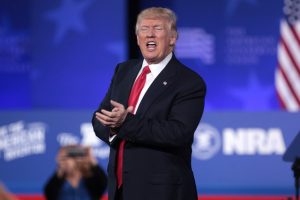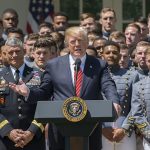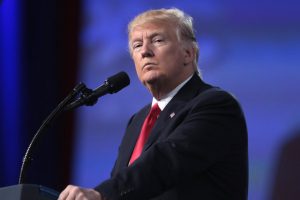by Tim Shorrock
A successful negotiation between President Donald Trump and North Korean dictator Kim Jong Un would have enormous ramifications for the East Asia region, including removing the US rationale for stationing military forces in the Japanese prefecture of Okinawa.
That’s the view of former Secretary of Defense William J. Perry, who led the Clinton administration’s efforts to defuse the first North Korean nuclear crisis in 1994 after coming close to launching a massive military strike on the country when it withdrew from the Nuclear Proliferation Treaty and began to build a bomb.
If Trump “is able to solve the North Korea threat and danger, that would go a long way to removing the rationale for even having military forces in Okinawa,” Perry told a Washington conference this week on the island chain where over 50 percent of the 70,000 US military personnel in Japan are stationed.
“I believe in time [this] would lead to a situation where the US forces in Okinawa could be removed altogether,” he added. Specifically, said Perry, a peace settlement in Korea would immediately eliminate the strategic rationale for the controversial US Marine base in Futenma, which has been a sore point between the US and Japan for decades and which a majority of Okinawans adamantly oppose.
That’s because the US Marines at Futenma are stationed there as the first line of defense if North Korean forces ever invade South Korea, said Perry, drawing on his experience in 1994. “The whole purpose of US military planning relative to North Korea is to get reinforcements in very, very quickly to stop North Korean forces before they get to Seoul,” he said. “A key component of that is the forces at Futenma—the rapid reinforcement of both land and air forces are key parts of that plan.”
Therefore, if a peace process involving both the United States and South Korea eliminated the threat of a North Korean invasion, US forces in Futenma and elsewhere in Okinawa could be “not just relocated but removed,” Perry argued. “That’s not going to happen obviously very soon. Whether it’s a serious prospect depends very, very much on the summit meetings.”
Path to Peace
Perry’s comments underscore the potential significance of the peace process now unfolding on the Korean Peninsula. Although the US media, anti-Trump liberals, and the growing number of North Korea “experts” in Washington have largely dismissed the upcoming talks as political theater likely to fail, the possibility of an end to the years-long Korean crisis has greatly encouraged South Koreans and drawn praise from Americans, like Perry, who have direct experience dealing with the North Korean government.
“If the summit comes to fruition, it could result in a historic breakthrough or set us on a path that could lead to a peaceful resolution of the current confrontation,” Suzanne DiMaggio of New America and Joel Wit of the U.S.-Korea Institute at Johns Hopkins SAIS wrote last week in Politico.
South Korea announced the talks between Trump and Kim at the White House on March 8. They came about after an extraordinary and unprecedented series of discussions between representatives of Kim Jong Un with South Korean President Moon Jae-in during the Winter Olympics in Pyeongchang, South Korea.
The North Korean delegates, who included Kim Yo Jong, Kim’s sister and top aide, and Kim Young Chol, North Korea’s chief of military intelligence, were the highest-ranking North Koreans to visit the South since the end of the Korean War in 1953. They brought an invitation to Moon to meet Kim for the first North-South summit since 2008.
Before agreeing to such a meeting, however, Moon insisted that North Korea agree to discuss the prospect of denuclearization with the United States. Two weeks ago, he sent his top national security advisers to Pyongyang where they met with Kim and received assurances that North Korea would freeze its nuclear and missile tests in return for a meeting with Trump to discuss denuclearization. Moon’s representatives delivered that message to Trump. To the shock of both North and South Korea, he accepted immediately.
Stakes for Okinawa
For Okinawans, however, a Korea summit and the months—and possibly years—of negotiations that would follow may be too long to wait for a settlement to their struggle against the US Marine presence. For decades, Okinawans living near the bases have suffered the loss of precious farmland, the constant sound of US jets and airplanes, and murders and rapes of Okinawan girls and women at the hands of US soldiers.
Under US-Japan agreements reached in 2006 and 2012, the US government pledged to relocate the Marines at Futenma to Guam and other sites outside of Japan in return for Japan building a new US Marine facility at Henoko in the northern part of Okinawa. But a majority of Okinawans opposes the new Henoko base—which will include runways that will destroy the ecologically sensitive Henoko Bay. The proposed base has been the scene of energetic protests from local activists.
“To construct a new facility that will take 15 or 20 years to build does not take into account the security landscape in Asia,” Okinawa Governor Takeshi Onaga said at the Washington conference, which was organized by Okinawa Prefecture and George Washington University. “Progress is really slow.” He added: “Our hope is to reduce the bases as much as possible. Yet the Japanese government is adamant about the [Futenma Replacement Facility] at Henoko.”
Meanwhile, Gov. Onaga said, US planes continue to plague Okinawa with serious accidents, including 30 crashes last year, while rapes and other crimes by US soldiers and contractors continue. Just this week, the US government said it would refuse to provide compensation to the family of a Japanese woman in Okinawa that a US military contractor murdered in 2016.
The democracy promised by the US-Japan Security Treaty “is not functioning,” Onaga continued. “Imagine the heartache of the Okinawan people…We are busy protesting to the [Japanese] Central Government, but nothing changes. That’s why I’m in Washington, DC.”
If Perry is right, that situation could change if the peace process on the Korean Peninsula is successful. But that’s a long way off. Unless the US and Japan can renegotiate their past agreements, Okinawa will continue to be in the crosshairs of American military strategy in Asia.
“I’m hoping that opinions from the US might change the course of the government in Japan,” former Japanese Prime Minister Yukio Hatoyama told me in an exclusive interview last month.
Hatoyama, a former member of the progressive Democratic Party of Japan, was forced out of office in 2009 after caving into US demands to build the base at Henoko. He was in Washington in February to discuss the Okinawa issue with US lawmakers, including Senators Dianne Feinstein and Bernie Sanders. “We need to listen to the voices of the [Okinawan] people,” Hatoyama said.
According to a 2016 report by the Congressional Research Service, “Okinawa hosts a disproportionate share of the continuing U.S. military presence” in Japan, “About 25% of all facilities used by U.S. Forces Japan and about half of the U.S. military personnel are located in the prefecture, which comprises less than 1% of Japan’s total land area.”
Tim Shorrock is a Washington-based journalist who writes about US national security and foreign policy for many publications at home and abroad. He is the author of Spies for Hire: The Secret World of Intelligence Outsourcing. Photo: Okinawans protest proposed base in Henoko (RyuFilms via Flickr).






There is currently no need for US troops in South Korea, and with peace breaking our there would surely be no need. The ROK military is much more powerful and better financed than the DPRK military.
Why is the US military in South Korea? To maintain the master-puppet relationship. A principal feature of that relationship is that the ROK military is commanded by a US general, a bilateral situation unique on the world. After sixty-plus years of this insane situation it’s time for a change.
Does this mean China will stop building fortress islands? Didn’t think so.
Excellent article with very sensible ideas. The huge number of US troops still in both Korea and Japan is ridiculous. I came to Japan in 1974 and if anything it seems like there are more now than when I came. So much ignorance on the part of Americans regarding the Korean conflict, US actions, corruption, incompetence, hubris, etc. Tim writes great articles of truth.